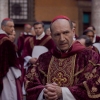
Cardinal O’malley (Brían F. O’Byrne) and Cardinal Lawrence (Ralph Fiennes) Conclave.
With the kind authorization of focus features
hide
tilting legend
With the kind authorization of focus features
This article contains spoilers for the film Conclave.
In the Oscar -winning film Conclave, The complex political structure of the Catholic Church is presented on the big screen while the college of cardinals meets to elect a new Pope. Based on a book of the same name of the novelist Robert Harris, the intrigue of the film is fictitious, but the papal electoral process, known as conclave, is real.
According to the Reverend Thomas Reese, columnist for the News Service religion with a doctorate. In political science at the University of California in Berkeley, the film was quite faithful to the truth.
“The voting procedure has been very well done,” said Reese: the ballot boxes used were perfect replicas of what is really used in combusting ballots.

He noted that one of the main inaccuracies of the film was the treatment of Cardinal Vincent Benitez, played by Carlos Diehz, who was appointed Cardinal pectoreA Latin sentence which results in “in the heart” and refers to a process where the meetings are fixed in secret. In reality, a cardinal who is named pectore cannot participate in a conclave unless his name was announced by the Pope before his death, which was not the case in the film.
Reese is the author of several books on the Catholic Church, including Inside the Vatican: the policy and organization of the Catholic Churchwhich details the conclave process. The process itself, said Reese, takes place in an external contact environment with all cardinals under the age of 80 until they reach a majority consensus of two thirds.

The white smoke rises from the chimney on the roof of the Sistine Chapel on March 13, 2013 at the Vatican after Jorge Mario Bergoglio in Argentina was elected Pope Francis.
Johannes Eisele / AFP via Getty Images
hide
tilting legend
Johannes Eisele / AFP via Getty Images
The cardinals are not alone. Casa Santa Marta, in the film and in real life, is led by nuns who – as a character of Isabella Rossellini, known as Sister Agnes – are supposed to be invisible, but nevertheless received eyes and ears.
In the film, Sister Agnes – who directs Casa Santa Marta – helps Sister Shanumi, a nun who had a secret relationship and a child with one of the first runners of Pope.
Caetlin Benson-Allott, director of film studies and media at the University of Georgetown, noted the interesting positioning of these two female characters.
“What I really liked is that you see both sides, you see the possibility that nuns play a more active role, because Cardinal Bellini suggests that they should, and you also see the history of sexual abuse and also the exploitation of women in the Catholic Church,” said Benson-Allott.

At the end of Conclave, Cardinal Benitez reveals that he is intersex, promoting the commentary of the film on gender roles in the church.
“The way Benitez spoke of discovering that he is intersex affirms both the normality and the beauty of intersex identity and recall the things Lawrence and Bellini said earlier in the film on the needs of progress,” said Benson-Allott.
A more progressive church is defended by Cardinal Lawrence, played by Ralph Fiennes and Cardinal Bellini, played by Stanley Tucci. Although each of them, at some point, is strong contenders for the papacy, none is elected at the end.
The sister Susan François is the deputy chief of the congregation in New Jersey for the sisters of Saint-Joseph de Peace. She said that the human elements of the electoral process were the most true for her in the film.

“While we wish and hope and pray that it is entirely a process of spiritual discernment, we are only human beings,” said his sister Susan. “It is impossible not to have the Egos, the concerns, the concerns not to reveal themselves, but yet, as people of faith, I think that the sisters hope and pray and desire to be more guided by the light of the Holy Spirit.”
Reese concluded that this complicated political campaign exists throughout the Church.
“The Church, we often say, is a divine institution ruled by men, and they are not all angels and saints,” said Reese. “Even when you have people of good will who work for the best of the church, for the well-being of the Church, there will be disagreements … It’s human and it’s normal.

Entertainment


